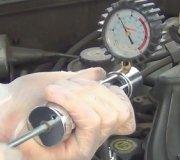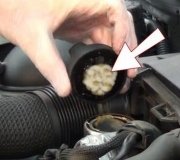2 or 3 days later with out driving it much the check engine light came on, I took the car to a mechanic l know and he said he got a misfiring code and than said it could be a blown head gasket, just like that. I got very disappointed, we change the distributor cap and rotor and reseted the code, two days later light came back on, this time we changed the sparkplugs and wires and reseted the code again. During this time, one day the radiator gauge almost got to the red area, I checked and it needed water, I poured some in and it all was good,
Days later I gave the car to my daughter and she said the light came back, I took the car back to the mechanic and he said he did a head gasket check with a pump and some blue liquid he added to the radiator, liquid than turned green and again he said the car had a blown head gasket, now the radiator gauge has been going up three quarters and my daughter has to stop and she has been adding water every day.
Today (Friday), I picked up the car and drove it to my house, the gauge stayed in the middle but when I got home I smelled coolant so I opened the hood and notice the coolant reservoir was up more than the limit and there was water all around it (like it came right out of the reservoir), the car also has a stain on the passenger floor near the door, I noticed it after removing the floor mat. (Its old)
Could you give me any advice? The reason I doubt the mechanic is because he is no longer working for the shop he used to work for (he is on his own and he has fixed the head gaskets on at list 4 cars in three weeks so I get the feeling he is giving people this diagnostics he can get more money to survive you know.
SATURDAY; Today I drove the car to a shop and ask the people there what my problem could be, the gay said the car looks like its been worked on head gaskets, he said he sees a new valve cover gasket and doesn’t think the heads are the problem. The fans worked and everything seemed to be ok. He said in case of overheating, to grab both water hoses and if one is cold that is a thermostat problem. Ok.
To test the car I got on the freeway and drove to Los Angeles (about 45 miles, 30 min. About 90 back and forth) the car worked well and the gauge stayed in the middle but when I got out of the freeway and started driving on the city, the gauge went up and up and up almost to the red mark (I had to turn on the heater to bring it back down and that’s how it stayed the rest of the day even after I let the car rest a couple of hours, when I got on it to go to the store the gauge went up all the way.
Please tell me what I should do?
SPONSORED LINKS
Saturday, April 3rd, 2010 AT 3:29 AM




